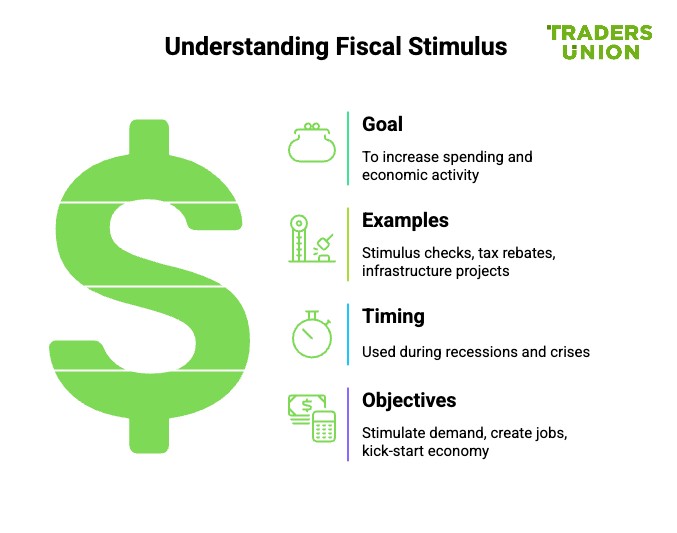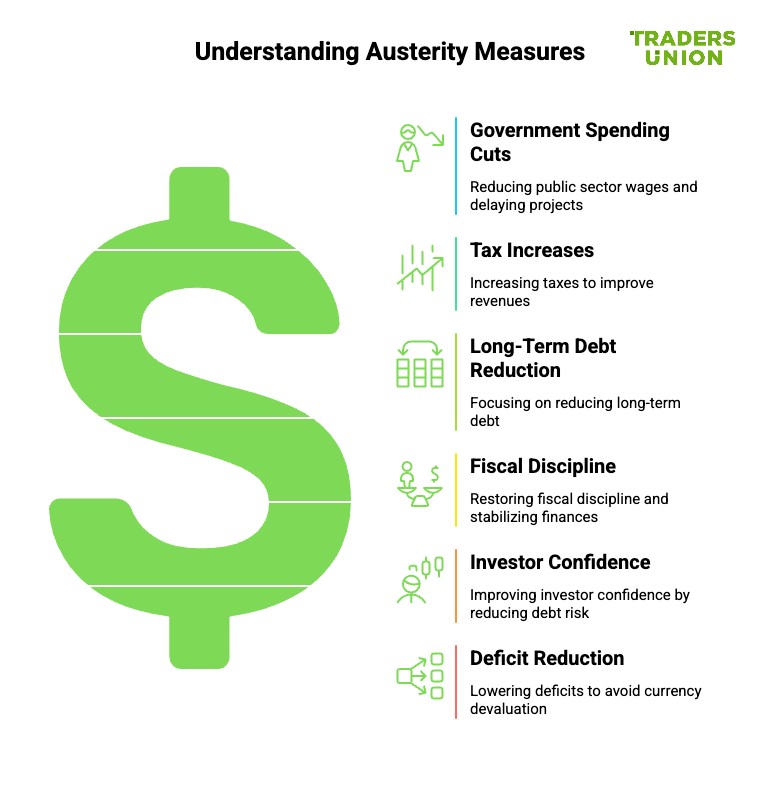
Fiscal Stimulus vs Austerity - Why Timing Matters For Both?
Fiscal stimulus boosts growth through government spending, while austerity reduces debt by cutting costs. Their success depends on timing, trust, and economic context, not ideology. Stimulus works best in downturns, austerity only when recovery is underway.
The debate between fiscal stimulus and austerity is not a textbook dilemma. It is a real-time test of how governments handle panic fear and political pressure when money dries up. One path pumps funds into the economy to keep the wheels turning while the other pulls back spending to control debt and avoid long-term damage. But the choice is never clean. What looks like rescue to one group can feel like recklessness to another.
The deeper truth is that timing size and credibility matter more than ideology. In this article, we cover the key point of difference between the two with an attempt to cover the need for each in detail.
Understanding fiscal stimulus and austerity
Governments manage their economies using two powerful tools: spending more or cutting back. These strategies can shape the path of recovery during downturns or cool down an overheated economy. Knowing the difference between the two helps explain why some countries bounce back faster from crises, while others face long, painful recoveries.
Definition of fiscal stimulus

Fiscal stimulus refers to when a government increases spending or cuts taxes to boost economic activity.
How it works
- The goal is to put more money in people’s pockets and get them spending.
- Common examples include stimulus checks, tax rebates, infrastructure projects, or increased welfare programs.
- Governments may run higher deficits temporarily to support growth.
When it’s used
- During recessions, economic slowdowns, or crises like COVID-19.
- To prevent unemployment from rising and keep businesses from closing.
What it aims to do
- Stimulate demand by encouraging consumers to spend and businesses to invest.
- Create jobs through public spending on services and construction.
- Kick-start a stalled economy and speed up recovery.
Definition of austerity measures

Austerity refers to when a government cuts spending or raises taxes to reduce budget deficits and debt levels.
How it works
- Governments reduce public sector wages, delay infrastructure projects, or limit welfare spending
- Taxes may be increased to improve revenues.
- Austerity usually targets reducing long-term debt rather than short-term growth.
When it’s used
- After a period of heavy borrowing or high inflation.
- When a government faces pressure from lenders or international institutions.
What it aims to do
- Restore fiscal discipline and stabilize public finances.
- Improve investor confidence by reducing debt risk.
- Lower deficits to avoid currency devaluation or rising borrowing costs.
Historical applications of fiscal stimulus and austerity
Economic shocks force governments to choose between spending to recover or cutting back to restore stability. History gives us clear examples of both strategies in action. From the sweeping stimulus packages of the 2008 crisis to the sharp budget cuts during the European debt crisis, these case studies show how policy choices can shape the pace and pain of economic recovery.
The 2008 global financial crisis and stimulus responses
The global economy hit a wall in 2008, with banking collapses, housing market crashes, and widespread job losses. In response, many governments turned to large-scale stimulus to prevent a complete meltdown.
What happened
- The US rolled out a $787 billion stimulus package in early 2009 through the American Recovery and Reinvestment Act.
- It focused on infrastructure, clean energy, tax cuts, and unemployment support.
- China responded even more aggressively, launching a $586 billion stimulus to fund housing, railways, and public works.
- Other major economies including the UK, Japan, and South Korea followed with their own spending packages.
Impact of the stimulus
- Prevented a deeper recession and helped stabilize financial systems.
- Restored some consumer and business confidence.
- Critics argued parts of the spending were inefficient, but it is widely credited with supporting early recovery.
Why it matters
- The 2008 response showed how fast, large-scale public spending could cushion the blow of a global shock.
- It also sparked debate about how much debt governments should take on in a crisis.
The European debt crisis and austerity measures
Just a few years after the 2008 crash, several European countries faced a new challenge: soaring debt and budget deficits. In response, many adopted austerity measures, especially those receiving financial aid from the European Union or the IMF.
What happened
- Greece, Spain, Portugal, and Ireland saw debt levels surge as tax revenues fell and public spending stayed high.
- In return for bailout funds, these countries agreed to strict austerity, cutting public sector wages, raising taxes, and slashing pensions.
- Greece saw particularly harsh cuts, with multiple rounds of layoffs and budget freezes.
Impact of austerity
- Budget deficits narrowed, and some investor confidence returned.
- However, unemployment soared, especially among youth, and economic growth slowed sharply.
- Public protests and political unrest became widespread, particularly in Greece and Spain.
Why it matters
- The European debt crisis showed that cutting too quickly can deepen economic pain.
- It highlighted the trade-off between reducing debt and protecting jobs and services.
Impacts of stimulus and austerity
When governments decide to spend more or cut back, the effects ripple through the entire economy. From job creation and GDP growth to debt levels and public services, both stimulus and austerity leave a lasting mark. These decisions not only shape economic outcomes but also influence public trust and political stability.
Effects on GDP growth and employment
When governments roll out stimulus plans, the aim is usually to jumpstart growth and get people back to work. Public projects and spending help generate jobs, boost demand, and create a ripple effect across the economy. It's a strategy that often works well after a recession.
Austerity, by comparison, pulls the brakes; cutting jobs and spending too soon can slow everything down and delay recovery. It can even hurt future productivity if critical investments are shelved. That’s why timing is everything: stimulus gives the economy a push when it’s weak, while austerity is better saved for calmer times.
Influence on public debt and deficits
Using stimulus often means borrowing more, and yes, deficits go up in the short run. But if the economy picks up, that debt becomes easier to handle. Austerity, on the flip side, tightens budgets and might ease borrowing costs, but if growth stalls, you’re stuck with the same debt and a weaker economy. It’s not just about numbers on a page; cutting too much too fast can backfire. Often, a thoughtful mix of targeted stimulus and careful long-term planning works better than swinging to extremes.
Impact on public services and welfare
When stimulus is done right, it often means more support for things people rely on; public hospitals, schools, and safety nets that protect families during tough times. It can prevent a slide into poverty and keep communities afloat. Austerity tends to shrink these services, leaving fewer options for those who need them most. That doesn’t just affect today, it can hold people back for years. Investing in public services during hard times helps the economy recover and keeps society more stable in the long run.
Political stability and public sentiment
People tend to respond well when they see the government stepping in to help during a crisis. Stimulus policies are often popular because they feel supportive and visible. Austerity, on the other hand, rarely gets applause. When budgets get cut and services disappear, people push back; sometimes in the streets, and sometimes at the ballot box.
Fairness matters. If it looks like only ordinary folks are paying the price while the wealthy stay untouched, resentment grows. These decisions aren't just economic; they shape how people feel about their leaders and the future.
Case studies
Real-world examples help bring economic theory to life. Two contrasting approaches after the global financial crisis highlight how different fiscal responses can shape a country’s recovery. The United States leaned into stimulus to revive growth, while the United Kingdom opted for austerity to reduce debt. Their paths and outcomes offer valuable lessons.
United States' stimulus approach during the 2008 crisis
When the financial system nearly collapsed in 2008, the US government responded with a massive fiscal stimulus.
What was done
- In early 2009, the Obama administration passed the American Recovery and Reinvestment Act, worth roughly $787 billion.
- The plan included tax cuts, expanded unemployment benefits, infrastructure investment, and funding for education and healthcare.
- This came on top of earlier bank bailouts and emergency spending to stabilize the economy.
Immediate impact
- Helped halt the economic freefall.
- Job losses slowed by mid-2009, and GDP began to grow again.
- While unemployment remained high for a few years, most economists credit the stimulus with avoiding a deeper recession.
Long-term outcome
- Growth returned gradually, and the recovery was steady but slow.
- Critics argued the stimulus was too small, while others warned about rising debt.
- Still, it laid the foundation for a longer period of expansion through the 2010s.
United Kingdom's austerity measures post-2010
In contrast, the UK took a different route: cutting spending to bring down deficits.
What was done
- In 2010, the newly elected coalition government introduced an aggressive austerity program.
- Public sector wages were frozen, welfare spending was capped, and major infrastructure projects were delayed or scaled back.
- The goal was to reduce the UK’s deficit, which had surged during the financial crisis.
Immediate impact
- GDP growth stalled in 2011 and 2012, and the recovery lagged behind the US.
- Public services saw reduced funding, and local governments struggled to maintain basic programs.
- Unemployment remained high, especially in regions reliant on government spending.
Long-term outcome
- The UK’s deficit did shrink, and borrowing costs remained low.
- But the economy took longer to return to pre-crisis levels, and inequality widened.
- Austerity also became a major political issue, influencing elections and public trust in government.
Evaluating effectiveness
Fiscal stimulus and austerity are not one-size-fits-all solutions. Their success depends on when they are applied, how they are structured, and what kind of economy they are dealing with. Some measures work well in the short run but cause issues later. Others may hurt in the beginning but help stabilize things over time. The real key lies in timing, execution, and economic context.
Short-term vs. long-term outcomes
Stimulus impact
- Short-term Stimulus often boosts growth quickly. Jobs return, spending picks up, and recession risks fall.
- Long-term If poorly targeted or excessive, it can increase public debt without long-lasting benefits. Inflation may also rise if the economy overheats.
Austerity impact
- Short-term. Cuts tend to slow the economy. Growth stalls, and unemployment often rises.
- Long-term. If managed well, austerity can bring down debt and restore confidence. But if too harsh, it can damage long-term investment and productivity.
What this means
- Quick results often come from stimulus, but the gains may fade without follow-through.
- Austerity might improve fiscal numbers, but it can take a heavy toll on growth and public trust if done too early.
Contextual factors influencing success

The same policy can have very different results depending on the situation.
Stage of the economic cycle
- During a recession, stimulus tends to work better by fueling demand.
- Austerity during downturns can deepen the pain.
- When growth is strong, austerity can help rebalance budgets without major harm.
Existing debt levels
- Countries with low debt may have room for more spending.
- Those with high debt may face higher borrowing costs and pressure to cut.
Monetary policy support
- Stimulus works best when interest rates are low and central banks are supportive.
- If monetary policy is tight, the benefits of fiscal spending may be limited.
- Austerity alongside loose monetary policy may help soften the blow.
Public trust and policy design
- Well-designed programs with transparency and clear goals work better.
- Poor communication or uneven implementation often weakens public support.
- Targeting the right sectors or people improves efficiency and political stability.
If you’re interested in investing based on fundamentals, I recommend you to trade using any of the brokers mentioned in the table below. They are known for providing a wide range of assets for trading along with important features for fundamental investing.
Conclusion
Fiscal stimulus and austerity are not rivals. They are tools that work only when used at the right time with the right story. Stimulus needs urgency but also trust. Austerity needs calm and the sense that we are fixing what worked. Both can fail when rushed, both can help when timed well. The real skill lies in knowing what the economy and the people need at that moment, not what the textbook says should come next.
Post a comment